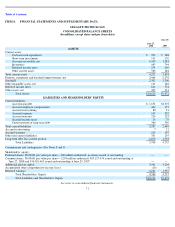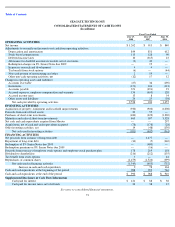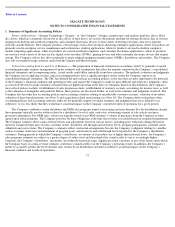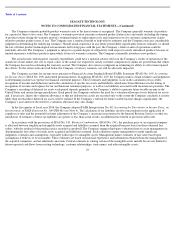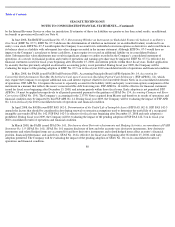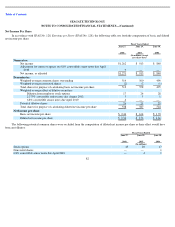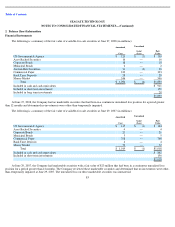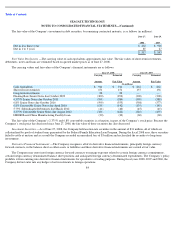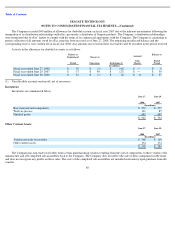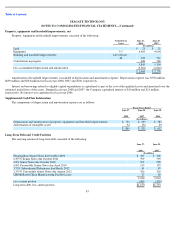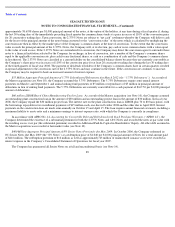Seagate 2007 Annual Report Download - page 80
Download and view the complete annual report
Please find page 80 of the 2007 Seagate annual report below. You can navigate through the pages in the report by either clicking on the pages listed below, or by using the keyword search tool below to find specific information within the annual report.
Table of Contents
SEAGATE TECHNOLOGY
NOTES TO CONSOLIDATED FINANCIAL STATEMENTS
—
(
Continued)
Derivative Financial Instruments —The Company applies the requirements of SFAS No. 133, Accounting for Derivative Instruments and
Hedging Activities
(SFAS No. 133) and SFAS No. 149, Amendment of Statement 133 on Derivative Instruments and Hedging Activities ,
(SFAS No. 149). Both standards require that all derivatives be recorded on the balance sheet at fair value and establishes criteria for designation
and effectiveness of hedging relationships (see Note 2).
Cash, Cash Equivalents and Short-Term Investments —The Company considers all highly liquid investments with a remaining maturity of
90 days or less at the time of purchase to be cash equivalents. Cash equivalents are carried at cost, which approximates fair value. The
Company’s short-
term investments are primarily comprised of readily marketable debt securities with remaining maturities of more than 90 days
at the time of purchase. The Company has classified its entire investment portfolio as available-for-sale. Available-for-sale securities are
classified as cash equivalents or short-term investments and are stated at fair value with unrealized gains and losses included in accumulated
other comprehensive income (loss), which is a component of shareholders’ equity. The amortized cost of debt securities is adjusted for
amortization of premiums and accretion of discounts to maturity. Such amortization and accretion are included in interest income. Realized gains
and losses are included in other income (expense). The cost of securities sold is based on the specific identification method. The Company
invests in auction rate securities. As of June 30, 2006 and June 29, 2007, auction rate securities that had stated maturities greater than three
months were classified as short-term investments unless they were purchased three months or less from contractual maturity. As of June 27,
2008, the Company reclassified all auction rate securities to long-term investments due to failed auctions (see Note 2).
Strategic Investments —The Company enters into certain strategic investments for the promotion of business and strategic objectives.
Strategic investments are included in the accompanying balance sheets in other assets, net, are recorded at cost and are periodically analyzed to
determine whether or not there are indicators of impairment. The carrying value of the Company’s strategic investments at June 27, 2008 and
June 29, 2007 totaled $34 million and $25 million, respectively.
Concentration of Credit Risk —The Company’s customer base for disc drive products is concentrated with a small number of OEMs and
distributors. Financial instruments, which potentially subject the Company to concentrations of credit risk, are primarily accounts receivable,
cash equivalents and short-term investments. The Company performs ongoing credit evaluations of its customers’ financial condition and,
generally, requires no collateral from its customers. The allowance for doubtful accounts is based upon the expected collectability of all accounts
receivable. The Company places its cash equivalents and short-term investments in investment-grade, highly liquid debt instruments and limits
the amount of credit exposure to any one issuer.
Supplier Concentration —Certain of the raw materials and components used by the Company in the manufacture of its products are
available from a limited number of suppliers. Shortages could occur in these essential materials and components due to an interruption of supply
or increased demand in the industry. If the Company were unable to procure certain of such materials or components, it would be required to
reduce its manufacturing operations, which could have a material adverse effect on its results of operations. In addition, the Company has made
prepayments to certain suppliers. Should these suppliers be unable to deliver on their obligations or experience financial difficulty, the Company
may not be able to recover these prepayments.
Newly Adopted and Recently Issued Accounting Pronouncements —In the first quarter of fiscal year 2008, the Company adopted FIN 48,
Accounting for Uncertainty in Income Taxes, an Interpretation of FASB Statement No. 109
– see Note 4 for additional discussion. The
calculation of tax liabilities involves uncertainties in the application of complex tax rules and the potential for future adjustment of the
Company’s uncertain tax positions
79




